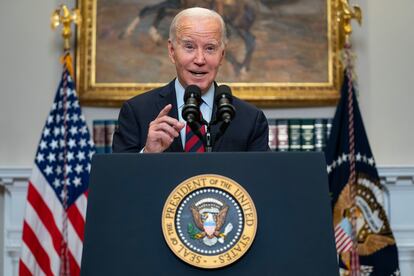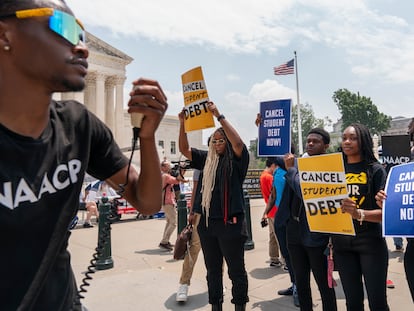Biden’s second try at student loan cancellation moves forward with debate over the plan’s details
Negotiators chosen by the Biden administration met for the first of three hearings on student loan relief in a process known as negotiated rulemaking

President Joe Biden’s second attempt at student loan cancellation moved forward Tuesday with a first round of negotiations to help guide the administration to a new plan.
The Biden administration vowed to try again after the Supreme Court rejected an earlier plan in June. In opening remarks at Tuesday’s hearing, Under Secretary of Education James Kvaal said the debt crisis threatens to undercut the promise of higher education.
“Student loan debt in this country has grown so large that it siphons off the benefits of college for many students,” Kvaal said in prepared remarks. “Some loans made to young adults stretch into retirement with no hope of being repaid. These debt burdens are shared by families and communities.”
Biden directed the Education Department to find another path to loan relief after conservatives on the high court ruled that he couldn’t cancel loans using a 2003 law called the HEROES Act.
The latest attempt will rest on a sweeping law known as the Higher Education Act, which gives the education secretary authority to waive student loans, although how far that power extends is the subject of legal debate.
The Education Department hopes to settle the dispute by adding federal rules that clarify when the secretary can waive student loans. To change those rules, however, the department is required to assemble a committee of outside negotiators to help hash out details.
The first day of negotiations, held virtually, lasted more than five hours but appeared to bring the department no closer to clarity. Much of the discussion centered on the shortcomings of existing student loan cancellation programs or problems caused by student loan interest.
Department officials repeatedly intervened to say those problems don’t fall under the scope of the current process.
The negotiators all come from outside the federal government and represent a range of viewpoints on student loans. The panel includes students and officials from a range of colleges, along with loan servicers, state officials and advocates including the NAACP.
It’s unclear who will be eligible for forgiveness under the new plan and how much relief they would get. Those details will be decided after the administration takes input from the negotiators, who meet in a series of sessions scheduled to continue into December.
Responding to suggestions from the panel, administration officials said they aren’t considering blanket cancellation.
“We are not looking at a broad-based debt cancellation where we are going to wipe off debt in its entirety. We are looking at individual ways that the secretary can exercise the authority to grant waivers,” said Tamy Abernathy, who leads a policy group in the department.
She later clarified that the department’s next proposal “could cancel some borrowers’ debt completely, but it could not cancel all borrowers debt completely.”
At the end of the process, negotiators will vote on a proposed rule drafted with input from their discussions. If they reach consensus on a proposal, the department will move forward with it. If they don’t, the agency will propose its own plan, which can be finalized after a public comment period.
The Education Department routinely uses negotiated rulemaking to enact federal regulation, and it’s required for any regulation related to student financial aid. It can be a long and painstaking process, and it often finishes without consensus among negotiators.
Biden has called for a new plan to help “as many borrowers as possible,” but it’s unclear whether it will be as expansive as his first proposal. That plan would have canceled up to $20,000 in federal student loans for borrowers with incomes below $125,000 or couples below $250,000.
Republicans rallied against the cancellation, saying it would add an unfair benefit for college graduates at the expense of millions of taxpayers who didn’t attend college. In 2022, about 47% of Americans age 25 or older had at least an associate degree, along with 15% who went to college but had no degree, according to the Census Bureau.
The administration plans to finalize the new rule sometime next year, but Education Secretary Miguel Cardona has declined to say if it will be in place before next fall’s presidential election. In a recent interview with The Associated Press, he said he’s working “as quickly as possible.”
He also noted that the court’s ruling “will have to factor in to the steps we take moving forward.”
Some legal analysts see the court’s decision as a rejection of any mass cancellation without action from Congress. The court concluded that the education secretary has power “to make modest adjustments and additions to existing provisions, not transform them.”
As a starting point for negotiators, the Education Department published an issue paper outlining some of the primary questions that will be up for debate. It offers few clues on the department’s vision for loan cancellation, but it identifies five groups of borrowers who may be in need of relief.
Negotiators are being asked how the agency should help:
- Borrowers whose interest grows so much that their balances exceed what they initially owed;
- Those who are eligible for loan cancellation under existing income-driven repayment plans but have not applied for those programs;
- Those who borrowed loans to attend college programs that didn’t lead to jobs with enough earnings to repay their loans;
- Borrowers with older loans taken out before Congress created benefits meant to ease the burden of student debt;
- Those who face hardships “that the current student loan system does not adequately address.”
It also asks negotiators to discuss the types of factors that would merit loan cancellation. The paper notes that, when deciding whether to collect on debt, some other federal agencies consider whether it “would be against equity and good conscience,” or if it would “impose financial hardship.”
At a White House briefing last week, Biden drew attention to the problem of ballooning interest. Many college graduates have been making payments for years, he said, “but because of interest, they still owe more than they originally borrowed.”
“My administration is doing everything it can to deliver student debt relief to as many as we can, as fast as we can,” Biden said.
The negotiators will meet virtually for two-day sessions on Nov. 6 and Dec. 11.
Sign up for our weekly newsletter to get more English-language news coverage from EL PAÍS USA Edition
Tu suscripción se está usando en otro dispositivo
¿Quieres añadir otro usuario a tu suscripción?
Si continúas leyendo en este dispositivo, no se podrá leer en el otro.
FlechaTu suscripción se está usando en otro dispositivo y solo puedes acceder a EL PAÍS desde un dispositivo a la vez.
Si quieres compartir tu cuenta, cambia tu suscripción a la modalidad Premium, así podrás añadir otro usuario. Cada uno accederá con su propia cuenta de email, lo que os permitirá personalizar vuestra experiencia en EL PAÍS.
¿Tienes una suscripción de empresa? Accede aquí para contratar más cuentas.
En el caso de no saber quién está usando tu cuenta, te recomendamos cambiar tu contraseña aquí.
Si decides continuar compartiendo tu cuenta, este mensaje se mostrará en tu dispositivo y en el de la otra persona que está usando tu cuenta de forma indefinida, afectando a tu experiencia de lectura. Puedes consultar aquí los términos y condiciones de la suscripción digital.
More information
Archived In
Últimas noticias
The new victims of the Republican war on Obamacare: Millions hit by soaring health insurance premiums
A country divided on migrant rights: Some US states expand protections while others restrict them
Venezuela authorizes the release of another 87 political prisoners
There is as much life left to discover on planet Earth as that which is already known
Most viewed
- David King, chemist: ‘There are scientists studying how to cool the planet; nobody should stop these experiments from happening’
- Reinhard Genzel, Nobel laureate in physics: ‘One-minute videos will never give you the truth’
- Oona Chaplin: ‘I told James Cameron that I was living in a treehouse and starting a permaculture project with a friend’
- Sinaloa Cartel war is taking its toll on Los Chapitos
- The Interoceanic Train, the Mexican alternative to the Panama Canal










































